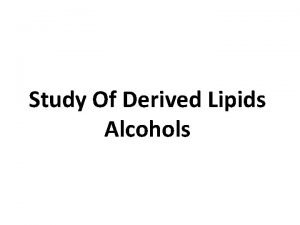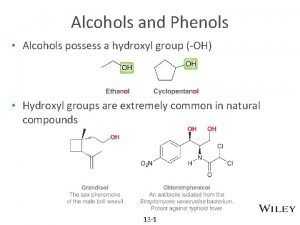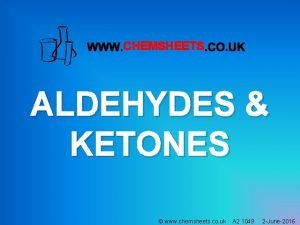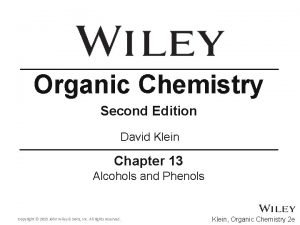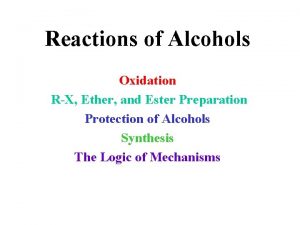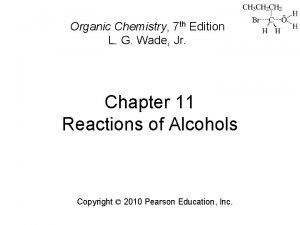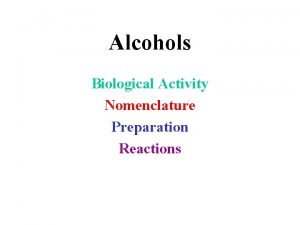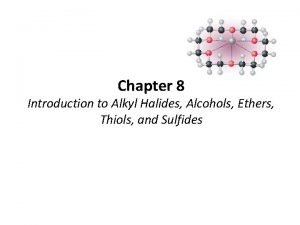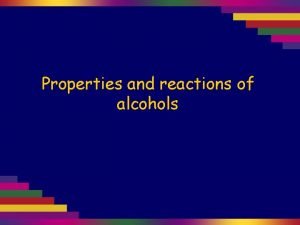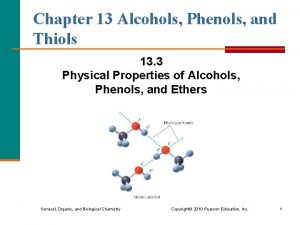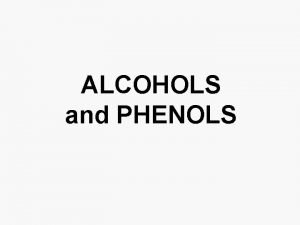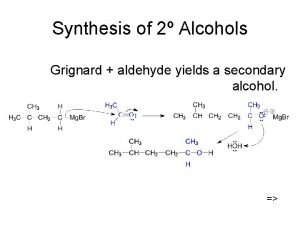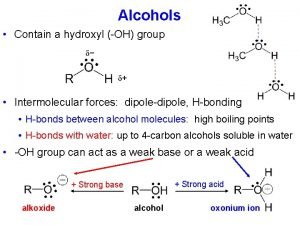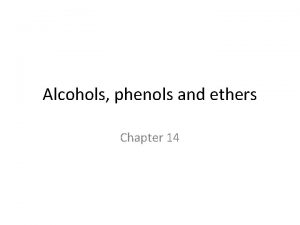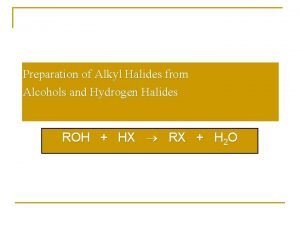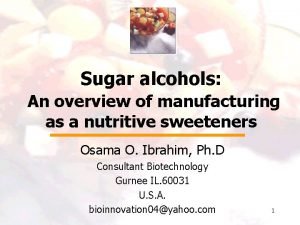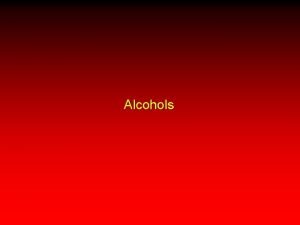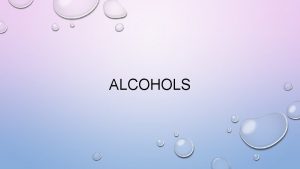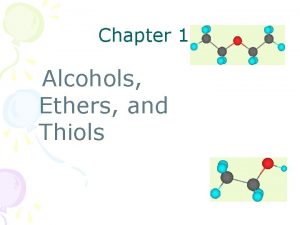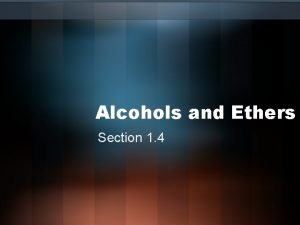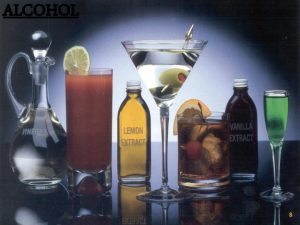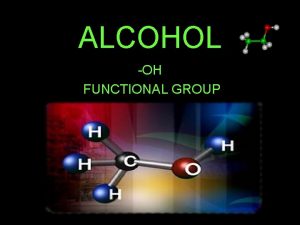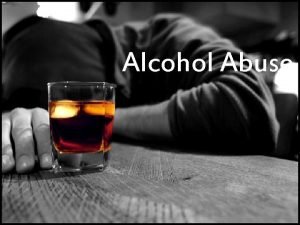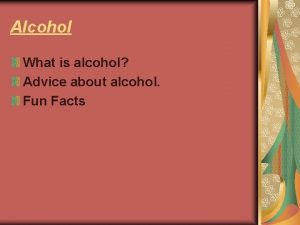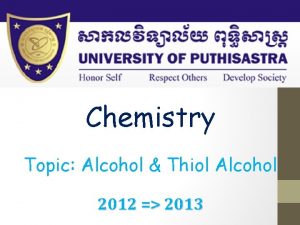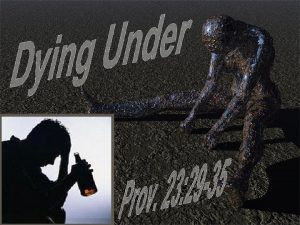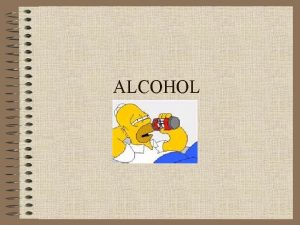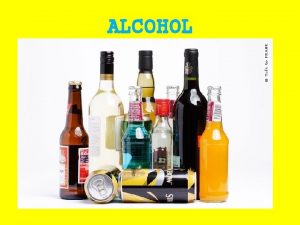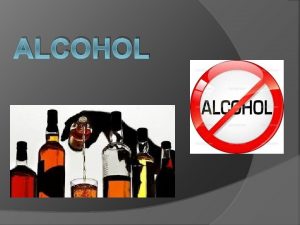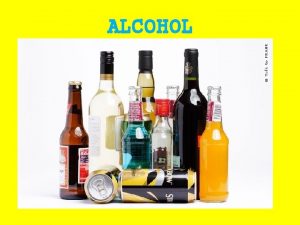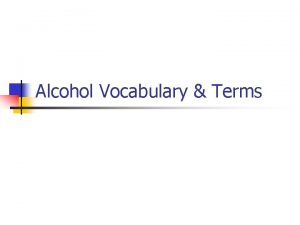ALCOHOLS What are Alcohols The term alcohol is






























- Slides: 30

ALCOHOLS What are Alcohols? The term alcohol is applied to all organic compounds whose molecules contain hydroxyl group, —OH, attached to a saturated carbon atom. The general formula is R-OH, R- Alkyl group - OH - the functional group of alcohol •

CLASSIFICATION OF ALCOHOL a. Aliphatic alcohol: OH group is linked to an aliphatic carbon chain i) Monohydric alcohol : Primary alcohol Secondary Alcohol Tertiary Alcohol CH 3 -OH Methanol ii) Dihydric alcohol iii) Trihydric alcohol

iv) Polyhydric alcohol eg: b) Aromatic Alcohol -OH group is linked to side chain of an aromatic hydrocarbons.

NOMENCLATURE OF ALCOHOL Alcohol Common Name Carbinol Name IUPAC Name R-OH Alkyl alcohol Carbinol Alkanol CH 3 -OH Methyl alcohol Carbinol Methanol CH 3 -CH 2 -OH n-Propyl alcohol Ethyl carbinol 1 -Propanol Isopropyl alcohol Dimethyl carbinol 2 -Propanol Isobutyl alcohol Isopropyl carbinol 2 -Methyl-1 -Propanol sec-butyl alcohol Ethyl methyl carbinol 2 -Butanol tert- Butyl alcohol Trimethyl carbinol 2 -Methyl-propan-2 -ol

GENERAL METHODS OF PREPARATION 1. Oxymercuration – demercuration (Markownokoff’s products) 2. Hydroboration – oxidation (Antimarkownokoff’s products) 3. Grignard synthesis (Reaction of RMg. X with Carbonyl comp & Epoxides) 4. Hydrolysis of alkyl halide 5. Aldol condensation 6. Reduction of carbonyl compounds 7. Reduction of acids and ester 8. Hydroxylation of alkene 9. Hydration of alkene 10. Hydrolysis of alkene

Grignard Synthesis of alcohols Formaldehyde – primary alcohol Acetaldehyde – Secondary alcohol Acetone – Tertiary alcohol Epoxide – Primary alcohol General Reaction: Reaction with Formaldehyde:

Reaction with Acetaldehyde Reaction with Acetone Reaction with Epoxide

Hydrolysis of Alkyl halide • Hydrolysis of alkyl halide is an example of Nucleophilic Substitution reaction. • Unimolecular Nucleophilic substitution reaction SN 1 eg: primary alkyl halides • Bimolecular Nucleophilic substitution reaction SN 2 eg: tert: alkyl halides • While secondary alkyl halide can undergoes either SN 1 or SN 2

Reduction of Carbonyl Compounds to alcohol Aldehyde – 10 alcohol Ketone - 20 Alcohol Reagents: 1. Catalytic hydrogenation 2. Chemical reducing agents like lithium aluminium hydride Exercise: • 2 -Butenal • 2 -butanone • Propanadehyde • Acetophenone

Reduction of acids and esters to alcohol Reduction of Carboxylic acids Carboxylic acid on reduction gives corresponding alcohol. Li. ALH 4 - one of few reagents. Excercise: Propionic acid, α- methyl butyric acid Reduction of Esters on reduction gives mixture of alcohols. Excercise: Ethyl acetate Propyl butyrate

Hydrolysis of ester to alcohol Reaction is carried out in presence of dilute solution of an alkali or a mineral acid, the organic esters are hydrolyzed to form the parent carboxylic acid and alcohol. Exercise: Propyl acetate, Methyl formate

ALDOL CONDENSATION Under the influence of dilute acid or base, two molecules of aldehyde or ketones, having alpha hydrogen atom may combine to form Beta-hydroxy aldehyde or Beta hydroxy ketone. The reaction is called as Aldol condensation.

Mechanism of Aldol Condensation

Applications of Aldol Condensation 1. Preparation of Saturated alcohol

Reactions of Alcohols 1. Reaction with hydrogen halide: Formation of alkyl halide 2. Reaction with PCl 3/PCl 5/SOCl 2: Formation of alkyl halide 3. Dehydration of alcohol: Formation of alkene 4. Reaction as an acids: Reaction with active metal 5. Ester formation: a) Reaction with acid chloride and b)Reaction with carboxylic acid 6. Oxidation of alcohol: Formation of aldehyde, ketone and acid 7. Catalytic dehydrogenation: Formation of aldehyde, ketone and alkene 8. Reaction with acetylene : Formation of acetal

1. Reaction with hydrogen halide: Formation of alkyl halide • Lucas Test • Differentiate Pri, sec and tert alcohols Order or reactivity of alcohol: 30>20>10 Order or reactivity of HX: HI > HBr > HCl Alkyl halide form is insoluble and shows turbidity. • 30 alcohol: Cloudiness immediately • 20 alcohol: Cloudiness within 5 minutes • 10 alcohol: No cloudiness at room temp. and gives cloud only on heating

2. Reaction with PCl 3/PCl 5/SOCl 2: Formation of alkyl halide

3. Dehydration of alcohol Refer Alkene Chapter for full detail 4. Reaction as an acids Reaction with active metal

5. Ester formation: Two methods a) Reaction with acid chloride and b)Reaction with carboxylic acid

6. Oxidation of alcohol: Formation of aldehyde, ketone & carboxylic acid • Used to differentiate pri, sec and tert alcohol • Loss of one or more α-H atom • Oxidising agents: KMn. O 4, Chromic acid, Cr. O 3 in glacial acetic acid Cr. O 3 in pyridine

7. Catalytic dehydrogenation: Formation of aldehyde, ketone and alkene Used for differentiating pri, sec and tert alcohol

8. Reaction with acetylene: Formation of acetal

Differentiate Between Primary Secondary & tertiary Alcohol Victor Meyer test 1. Oxidation test: Also known as Dichromate test 2. Catalytic dehydrogenation 3. Lucas test: Reaction with Hydrogen halide 4. Victor Meyer test

Structure and uses of Ethyl alcohol, chlorobutanol, cetosteryl alcohol, benzyl alcohol, glycerol, propylene glycol Ethyl alcohol CH 3 -CH 2 -OH, CN: Ethyl alcohol, IUPAC: Ethanol • It is the exhilarating principle of all wines and is also named as Spirit of Win • Technicaly it is known as Grain alcohol, since it is often manufactured from starchy grains. Ethyl alcohol is used : (1) as a fuel for lamps and stoves. For the sake of convenience in transportation, it is converted into solid state (Solid alcohol) by dispersion in saturated calcium acetate and a little stearic acid (2) as a substitute of petrol in internal combustion engines (3) as a solvent for drugs, tinctures, oils, perfumes, inks, dyes, varnishes (4) as a beverage (5) as a preservative for biological specimens (6) as an antifreeze for automobile radiators (7) as a low freezing ( fp -11. 7°) and mobile fluid in scientific apparatus such as thermometers and spirit level (8) as a raw material for large number of organic compounds including ethylene, ether, acetic acid, iodoform, chloral etc. (9) for manufacture of terylene and polythene.

Structure and uses of Glycerol • Glycerol is the simplest trihydric alcohol (triol). • The name glycerol or glycerine was originally derived from the word glyceros, meaning sweet. • It is a trihydroxy derivative of propane. It occurs in almost all natural animal fats and vegetable oils as the glyceryl esters of higher organic acids. Uses: Glycerol is used (I) as a sweetening agent in beverages and confectionary (ii) in the preparation of high class toilet soaps and cosmetics; (iii) in preserving tobacco from drying out (iv) as antifreeze in automobile radiators (v) for lubricating fine machinery such as watches and clocks; (vi) as a preservative for fruits & other eatables which require to be kept moist (vii) in making printing inks and inks for stamp pads (viii) in the preparation of nitroglycerine (ix) as a starting material for several allyl and propyl derivatives, and (x) for the manufacture of glyptal plastics used for artificial fibers.

Structure and uses of Benzyl alcohol • It is the simplest member of the class and is isomeric with cresols. • It occurs is Peru and Tolu balsams as free alcohol and as esters (acetate and benzoate) oil of Jasmine and other essential oil. 1. Benzyl alcohol and its esters are largely used in the perfumery industry. 2. Being a local anaesthetic and antiseptic, it is used in making ointments for relieving itching. 3. Benzyl benzoate Is a remedy for asthma and whooping cough.

Structure and uses of Cetostearyl alcohol, cetearyl alcohol or cetylstearyl alcohol is a mixture of fatty alcohols consisting predominantly of cetyl and stearyl alcohol and is classified as a fatty alcohol. CH 3 -(CH 2)n-CH 2 -OH It is used as 1. an emulsion stabilizer 2. an opacifying agent, 3. foam boosting surfactant 4. an aqueous and non-aqueous viscosity-increasing n – Variable, 14 -16 Cetostearyl alcohol agent. 5. It imparts an emollient feel to the skin and can be used in water-in-oil emulsions, oil-in-water emulsions and anhydrous formulations. 6. It is commonly used in hair conditioners and other hair products.

Structure and uses of Propylene Glycol 1. Propylene glycol is used as a humectant 2. preservative in food and for tobacco products 3. It is also one of the major ingredients (<1– 92%), along with glycerol, of the e -liquid and cartridges used in electronic cigarettes where it is aerosolized in the atomizer 4. Propylene glycol is also used in various edible items such as coffee-based drinks, liquid sweeteners, ice cream, whipped dairy products and soda. 5. Vaporizers used for delivery of pharmaceuticals or personal-care products often include propylene glycol among the ingredients. 6. used as chemical feedstock for the production of unsaturated polyester resins

7. reacts It with propylene oxide to give oligomers and polymers that are used to produce polyurethanes. 8. including oral, injectable and topical formulations, such as for diazepam and lorazepam which are insoluble in water. 9. Certain formulations of artificial tears, such as Systane, use proplyene glycol as an ingredient 10. aircraft de-icing fluid. 11. Propylene glycol is frequently used as substitute a for ethylene glycol in low toxicity, environmentally friendly automotive antifreeze. 12. It is also used to winterize the plumbing systems in vacant structures. 13. for hyperketonaemia in ruminants. 14. to propionate which can be used as an energy source. The remainder is absorbed into the for gluconeogenesis. bloodstream and used by the liver

Structure and uses of Chlorobutanol (trichloro-2 -methyl-2 -propanol) 1. It is used as a preservative, sedative, hypnotic and weak local anesthetic. 2. similar in nature to chloral hydrate. It has antibacterial and antifungal properties. 3. Chlorobutanol is typically used at a concentration of 0. 5% where it lends long term stability to multi-ingredient formulations. 4. However, it retains antimicrobial activity at 0. 05% in water in injection, eye drop ointment and cosmetics.
 Insidan region jh
Insidan region jh Secondary alcohols
Secondary alcohols Oxidation primary alcohol
Oxidation primary alcohol Cppp nucleus
Cppp nucleus Oh group in phenol is
Oh group in phenol is Reactions of alcohols 1 chemsheets answers
Reactions of alcohols 1 chemsheets answers Alcohols nomenclature
Alcohols nomenclature Alcohol and hbr
Alcohol and hbr Lucas test reaction
Lucas test reaction What does na2cr2o7 do
What does na2cr2o7 do Alcohols nomenclature
Alcohols nomenclature Lucas reagent equation
Lucas reagent equation Alcohols phenols thiols and ethers
Alcohols phenols thiols and ethers Acidity of alcohols
Acidity of alcohols Grignard reagent formula
Grignard reagent formula Butanone isomers
Butanone isomers Naming ethers
Naming ethers Preparation of alkyl halides from alcohols
Preparation of alkyl halides from alcohols Erythritol production process
Erythritol production process Short term human resources
Short term human resources Long term goal
Long term goal Minterm and maxterm
Minterm and maxterm Term-to-term rule
Term-to-term rule Position-to-term rule
Position-to-term rule Short term finance planning
Short term finance planning Term to term rule example
Term to term rule example Long term memory vs short term memory
Long term memory vs short term memory Difference between long term and short term liabilities
Difference between long term and short term liabilities Term to term rule
Term to term rule Nth term of a sequence
Nth term of a sequence Long-term liabilities examples
Long-term liabilities examples



